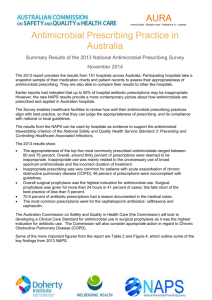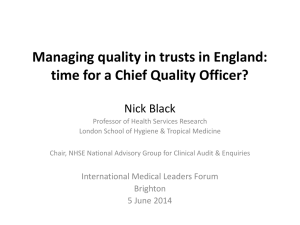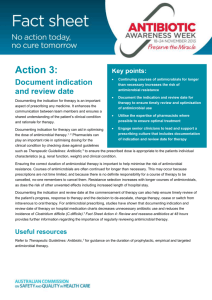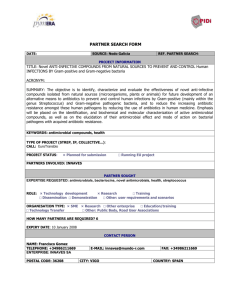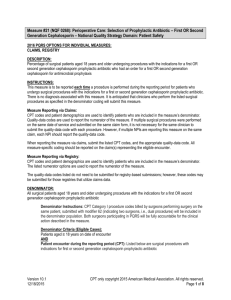The evidence base for policies
advertisement
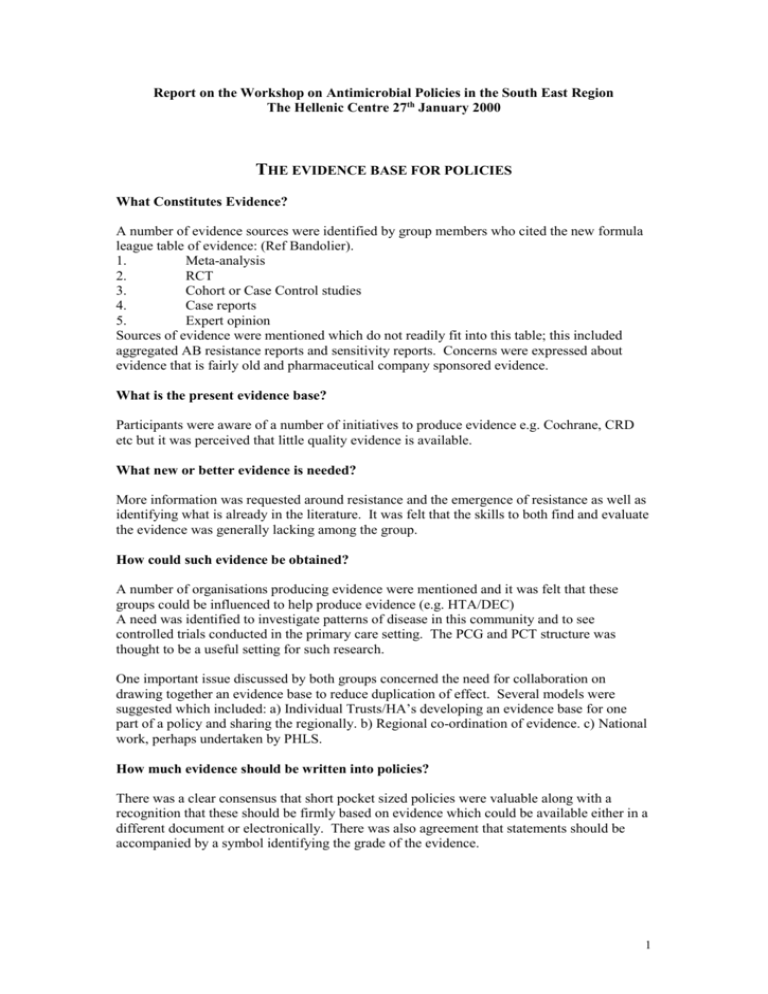
Report on the Workshop on Antimicrobial Policies in the South East Region The Hellenic Centre 27th January 2000 THE EVIDENCE BASE FOR POLICIES What Constitutes Evidence? A number of evidence sources were identified by group members who cited the new formula league table of evidence: (Ref Bandolier). 1. Meta-analysis 2. RCT 3. Cohort or Case Control studies 4. Case reports 5. Expert opinion Sources of evidence were mentioned which do not readily fit into this table; this included aggregated AB resistance reports and sensitivity reports. Concerns were expressed about evidence that is fairly old and pharmaceutical company sponsored evidence. What is the present evidence base? Participants were aware of a number of initiatives to produce evidence e.g. Cochrane, CRD etc but it was perceived that little quality evidence is available. What new or better evidence is needed? More information was requested around resistance and the emergence of resistance as well as identifying what is already in the literature. It was felt that the skills to both find and evaluate the evidence was generally lacking among the group. How could such evidence be obtained? A number of organisations producing evidence were mentioned and it was felt that these groups could be influenced to help produce evidence (e.g. HTA/DEC) A need was identified to investigate patterns of disease in this community and to see controlled trials conducted in the primary care setting. The PCG and PCT structure was thought to be a useful setting for such research. One important issue discussed by both groups concerned the need for collaboration on drawing together an evidence base to reduce duplication of effect. Several models were suggested which included: a) Individual Trusts/HA’s developing an evidence base for one part of a policy and sharing the regionally. b) Regional co-ordination of evidence. c) National work, perhaps undertaken by PHLS. How much evidence should be written into policies? There was a clear consensus that short pocket sized policies were valuable along with a recognition that these should be firmly based on evidence which could be available either in a different document or electronically. There was also agreement that statements should be accompanied by a symbol identifying the grade of the evidence. 1 Other Issues Raised. There were some suggestions of a standard format for on antimicrobial policy which would need to be recognise on a supra-regional basis to account for the medical rotations currently in place. This approach would help staff who rotate and could help in the production of evidence base policies. UPDATING POLICIES Ideals for updating antimicrobial policies To review policy, but not always change it, at least once every 2 years To have a rolling programme of updates To have audits of policies and feedback from users when making the reviews To have a small writing group To check the evidence base To engage the users To have the update approved by local drugs and therapeutics/prescribing committee To use the review as an opportunity to liase between hospitals and with GPs Difficulties in writing updates Shortages of audit results and feedback Lack of co-terminosity, and changes, in the areas served by NHS trusts and health authorities Movement of junior doctors and locums Limited teaching and learning time False perception that pharmacists should police prescribing practice (Sometimes) lack for consultant support Making decisions when there is insufficient evidence, although price may be the final determinant. Actions to consider when rolling out updates of antimicrobial policies Change the antimicrobials in the pharmacy stock Train and inform nurses Designate individuals to see that colleagues know of the updates Remember part-time staff Get the old policies back/off the wards Set and write the expiry/review date 2 SURGICAL PROPHYLAXIS Points raised Acceptance of multiple policies for different departments and types of surgery, and the need to compromise on ideals to get a policy accepted The opinions expressed about the evidence base on surgical prophylaxis: Good evidence for prophylaxis in colo-rectal surgery:. Risk assessment plays a large part in prophylaxis for vascular and neuro-surgery Little evidence in urology, except for preventing septicaemia when UTI present Obstetrics – mostly USA based research The evidence in orthopaedics is becoming dated, as done in the 1980’s The policy should take account of likely pathogens and their sensitivities Surgical prophylaxis always should be a single dose given in theatre There is a strong tendency towards defensive practice, copying others, and extrapolating from existing practice “Best practice” is a source of uncertainty BNF has details but is of limited help Antimicrobial prophylaxis not a substitute for theatre hygiene Disadvantages of surgical prophylaxis Cost Risk of C. difficile and other adverse reactions Possible effect to increase resistance (the group were uncertain that this occurred) Ways forward To seek a lead from the Royal Colleges for national guidance and consistency To recognising the weakness of the evidence for some surgical prophylaxis To stimulate multicentre studies and discussion To resist unscientific extension of existing practice for defensive reasons OWNERSHIP & TARGET AUDIENCE Who is responsible for setting antimicrobial policies? Those who prepare an antimicrobial policy need a clear mandate, and delegated responsibility. National guidance is sometimes useful, but there has to be local management. The policy should be linked to clinical governance. Owners of policies Trusts (microbiologists and pharmacists) HAs (CCDCs and prescribing leads) PCGs Regional Office (regional pharmaceutical advisers and regional epidemiologists) Target audience for policies Hospital staff Community GP/primary care nurses/practice pharmacists Dentists Community pharmacists Podiatry The public HAs PCGs Trusts 3 In a hospital trust, the antimicrobial policy authors may be a subgroup of the drugs and therapeutics committee, and may include (or consult) Consultant microbiologist Hospital pharmacist Pharmacologist Infection control nurse General nurse Infectious diseases physician A representative of general practice Representatives of clinical departments The means of developing antimicrobial policies in PCTs and community trusts in future were still uncertain. Other stakeholders in antimicrobial policies are Pharmacists Some GPs Some hospital doctors Some nurses Pharmaceutical industry Whereas it should be all doctors, all nurses, patients and the public Impediments to ownership Poor evidence base Poor marketing of policy Not involved, so not listening Poor access to data Regulations can sometimes create perverse incentives CONTENTS OF POLICIES The following points were made about the presentation of the policy The aims are to be clear , easy to understand, and quick to use The choice of format (handbook, filofax, read via a computer, A4 folder) should be influenced by user preference, and could take two forms: a portable version and a larger reference folder. New doctors and locums must be able to find the policy quickly. The policy should be presented as multi-disciplinary, to include nurses and pharmacists The format chosen for hospitals is not necessarily the most suitable for primary care The policy should give contact names and numbers for more information and evidence, to avoid being cluttered and complicated. It is possible to indicate the strength of evidence behind the statements in a policy, although this might encourage departure from guidance where the evidence was weak. Doses may be included or a reference to more information on dose Update/ review date needs to be stated 4 An antimicrobial policy does not stand alone, e.g. antimicrobials are only part of surgical procedures to prevent infection. So a policy may be part of a larger formulary or of a set of departmental policies. If it is the latter, there must be consistency with the whole hospital policy. Although editing paper-based policies can be tricky when several policies need updating, editing a computer based policy may not be any easier. Considerations for having special groups, e.g. pregnant women and children, in a policy As a minimum, policy should indicate when there are exceptions to the general policy, because of age or pregnancy. The British National Formulary has detailed information. For children, the drugs tend to be the same, so the issue is whether to include dosage or not. Apart from children the elderly and pregnant women, other groups that may be considered are patients in genito-urinary clinics, oncology, or with tuberculosis. Side effects and contra-indications It is important to warn if the recommended drug is contra-indicated for children and pregnant women, and patients with renal or hepatic failure. Should the policy be advisory or mandatory? The subgroup considering this question had a majority in favour of hospitals having policies that staff must follow, with certain exceptions. For general practitioners, the policies were considered to be advisory, i.e. guidance on best local practice. THE AUDIT AND MONITORING OF POLICIES Key points Producing guidelines is easier than auditing them. The policy should determine what is audited because standards established Audit can be incorporated in training Feedback and good communication are essential How can it be proved that antimicrobial policies make a difference? How valuable is audit in reflecting day to day practice? Electronic prescribing system can improve data quality. We should be aiming to raise data quality to facilitate audit. Audit is in place or planned in more than half of the trusts and districts represented. Audit methods Retrospective audits are likely to encounter poor quality information from inadequate data in patient records A Cross-sectional study (= Snap shot audit) is a possibility Prospective audits can distort practice and are very time consuming - resource may not permit. May be worth piloting optical mark records (scanning tick boxes on forms) 5 What can be audited? Compliance with policy Comprehensiveness of policy Distribution/awareness Effectiveness Reasons for deviating from policy Costs Who gets what and when? Trends C. difficile infection rates Duration and dose of treatment Thoughts on Audit in Hospital Audit can be condition based where guidelines exist for specific conditions. Follow the Dundee example where key questions are asked when prescribing antimicrobials. How is appropriate use to be defined? Surgical prophylaxis is easier to monitor if prophylaxis is separated from therapy in prescription charts. Hospital information systems could measure specified parameters electronically. Quantitative assessment is easier than qualitative The visits of consultant microbiologists to wards can promote care and interest in antimicrobial use Hospital data systems on antimicrobial treatment, and infection are often not connected Thoughts on Audit in General Practice PCGs could become counter-productive if they lead to multiple guidelines into many different versions. This is compounded by losing critical mass if the health authority audit team are shared out and fragmented amongst PCGs In the past, the focus has been on cost savings only. Communication can be difficult. Role for pharmaceutical adviser? First line treatment in general practice will be empirical Limited discussions between community pharmacists and GPs Linkage of clinical information to prescribing practice Thoughts on regional activities Regional monitoring charts could be a template for discussion at a local level. Regional comparison data useful to inform Offering external monitoring? Must permit consideration of local factors, recognising that local interpretation is necessary 6

